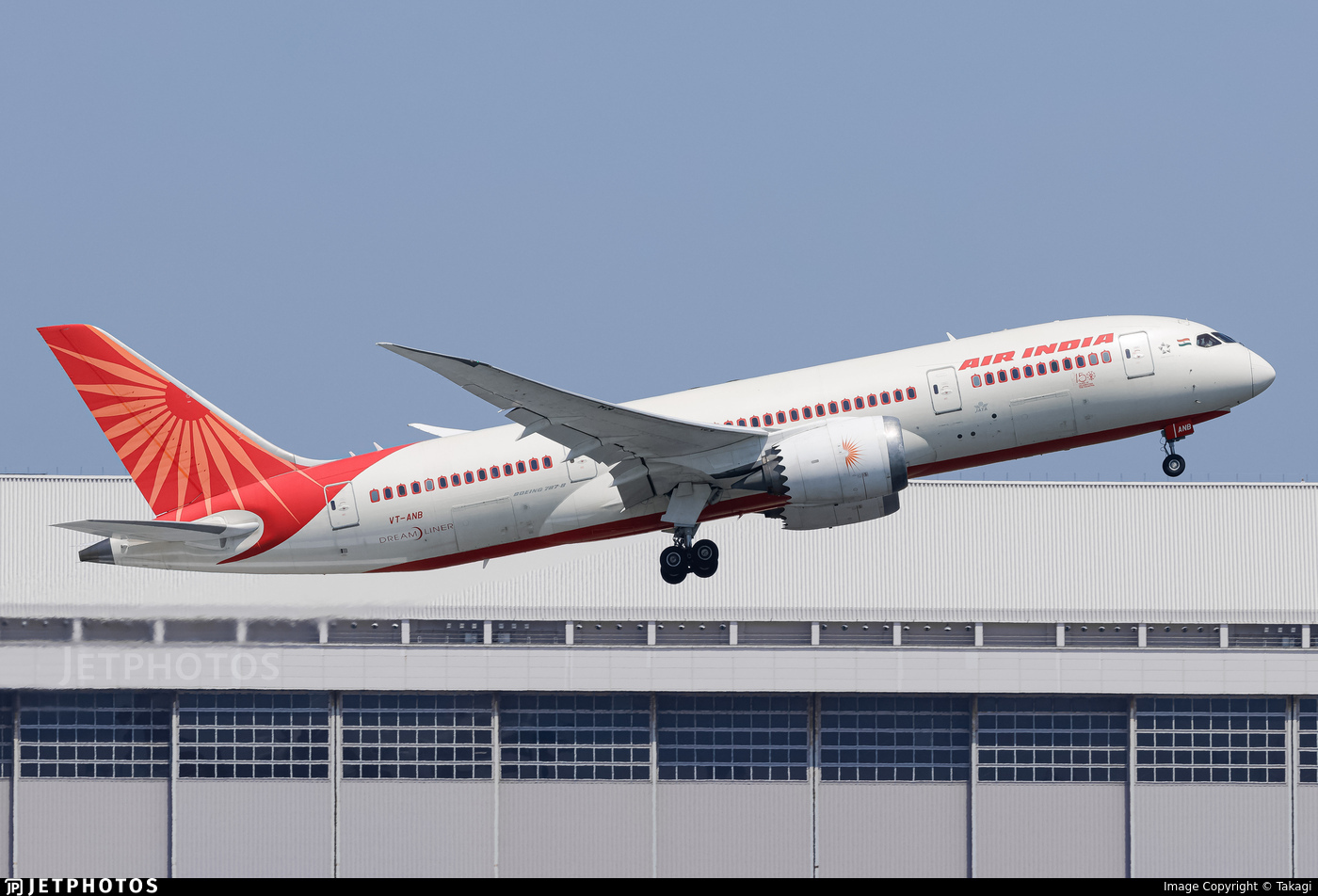AI Boeing 787-8 Dreamliner
On June 12, 2025, an Air India flight (AI171) departed from Sardar Vallabhbhai Patel International Airport in Ahmedabad, bound for London Gatwick. The aircraft was a Boeing 787 Dreamliner, a modern wide-body jet known for long-haul international travel.
- Just after takeoff, within a few minutes, the flight issued a MAYDAY call, which is an international emergency distress signal indicating immediate danger.
- The aircraft reached only 625 feet in altitude, which is very low for a commercial jet during initial climb. Suddenly, the plane lost altitude and crashed into a hostel building belonging to J. Medical College, located close to the airport. The crash caused a massive explosion and fire, killing 241 of the 242 people on board, including both passengers and crew.
How Does an Aircraft Normally Take Off and Climb?
- Every commercial flight undergoes a detailed pre-flight checklist, which includes mechanical inspections, fuel level checks, engine condition, and weather evaluation.
- Once airborne, the aircraft normally climbs steadily to a safe altitude, typically 1,000 feet within the first 1–2 minutes.
- After reaching a safe climb rate, the aircraft is often handed over to autopilot, which maintains altitude, direction, and engine settings.
- If any critical system—such as engines, flight controls, sensors, or computers—fails, the pilot is trained to respond using emergency procedures.
What is MAYDAY call?
A “Mayday” call is an international distress signal used in aviation and maritime communication.
- It originates from the French expression “m’aidez”, which means “help me” or “come to my aid”.
- Pronounced: “meh-day”
- Comes from: “Venez m'aider” = “Come help me”
- In the 1920s, a British radio officer named Frederick Stanley Mockford, working at Croydon Airport (UK), coined the term.
- He chose "Mayday" because many pilots and air traffic controllers spoke both English and French.
- In 1927, the International Radiotelegraph Convention officially adopted “Mayday” as the standard emergency word in both aviation and maritime sectors.
- When a pilot or ship captain says “Mayday” three times ("Mayday, Mayday, Mayday") on radio, it alerts Air Traffic Control (ATC) or other stations that immediate rescue or emergency help is needed.
Who Is Investigating?
- The investigation is being led by India’s Aircraft Accident Investigation Bureau (AAIB), with technical support from Boeing, GE Aerospace (engine manufacturer), and international regulators like the FAA (USA) and NTSB.
- The black boxes have already been recovered and are being examined to understand what was happening in the cockpit and how the systems behaved in those final moments.
What is a Black Box in Aviation?
Despite the name, the black box is not black. It is typically bright orange with reflective tape to aid visibility after a crash.
There are actually two black boxes on every commercial aircraft:
- Flight Data Recorder (FDR)
- What it records: Over 80+ flight parameters, including altitude, airspeed, vertical acceleration, heading, engine performance, autopilot settings, control surface positions.
- Duration: Stores data for at least 25 hours of flight time.
- Purpose: Helps reconstruct what the aircraft was doing before an incident.
- Cockpit Voice Recorder (CVR)
- What it records: Audio from the cockpit — conversations between pilots, alarms, engine noises, and radio communications with ATC (Air Traffic Control).
- Duration: Stores the last 2 hours of cockpit audio.
- Purpose: Reveals human factors, miscommunications, and in-cockpit decision-making during emergencies.
Why Is This Crash So Significant?
- This is the first fatal crash of a Boeing 787 Dreamliner since it was introduced in 2011, making it a global aviation concern.
- The crash has led to a drop in Boeing’s stock prices due to fears of safety issues and potential lawsuits.
- It is also India’s deadliest plane crash since 1996, surpassing even the tragic 2010 Mangalore Air India crash in terms of overall fatalities.
- The fact that the plane crashed into a populated area (a medical hostel) has intensified public outrage and sorrow, with many young doctors among the victims.
What is Boeing 787 - 8 Dreamliner?
The Boeing 787-8 Dreamliner is a wide-body, long-haul commercial aircraft developed by the Boeing Commercial Airplanes division. It's part of the 787 Dreamliner series, which includes 787-8, 787-9, and 787-10 variants.
- First flight: December 15, 2009
- Entered service: October 2011 with All Nippon Airways (ANA)
- Capacity: Typically 242 passengers (2-class configuration)
- Range: ~13,620 km (ideal for ultra-long-haul routes)
Indian Operators
- Air India was the first Indian carrier to induct the 787-8 in 2012.
- As of now, Air India, Vistara, and Air India Express (in merger transition) operate Dreamliners on long-haul and premium international routes such as:
- Delhi–London
- Mumbai–Newark
- Chennai–Frankfurt
Safety Record and Issues
The 787 Dreamliner has a good overall safety record, but some notable issues have emerged:
Battery Fires (2013)
- Lithium-ion batteries caught fire on two aircraft.
- Resulted in a 3-month global grounding
- Boeing redesigned battery containment and cooling systems.
Technical Alerts
- In-service issues like fuel leaks, electrical panel malfunctions, engine icing, and structural paint peeling have occurred.
- Several safety bulletins issued by FAA (Federal Aviation Administration), though no fatal crashes have been reported.
India’s Major Air Crashes: A Timeline of Tragedies
Over the years, India has witnessed multiple air accidents, claiming hundreds of lives even before passengers could reach their destinations. Most of these accidents were caused due to a combination of technical failures, adverse weather conditions, and human errors.
- August 7, 2020 – Kozhikode, Kerala
An Air India Express Flight 1344, while attempting to land on the runway at Kozhikode International Airport, overshot the runway and plunged into a nearby valley.- The aircraft broke into two pieces.
- Out of 190 passengers, 21 people died, including both pilots.
- The crash occurred due to heavy rainfall and poor weather conditions.
- May 22, 2010 – Mangaluru, Karnataka
A Boeing 737-800 operated by Air India crashed during landing at Mangalore International Airport.- The aircraft slid off a tabletop runway into a gorge and caught fire.
- 158 people died.
- The pilot misjudged the landing approach due to the difficult terrain.
- July 17, 2000 – Patna, Bihar
Alliance Air Flight 7412 crashed into a residential area near Patna while approaching the runway.- 60 people died, including 55 passengers and 5 civilians on the ground.
- The crash occurred during the final landing phase.
- November 12, 1996 – Charkhi Dadri, Haryana
In India’s worst-ever air disaster, a Saudi Arabian Airlines Flight 763 collided mid-air with a Kazakhstan Airlines Flight 1907.- Both aircraft crashed, killing 349 people.
- The accident was caused by a failure in communication and coordination between the two aircraft.
- February 14, 1990 – Bengaluru, Karnataka
Indian Airlines Flight 605 crashed just before landing at HAL Airport.- The aircraft hit the ground beside the runway and crashed into a nearby golf course.
- Out of 146 people on board, 92 died.
- October 19, 1988 – Ahmedabad, Gujarat
Indian Airlines Flight 113 struck trees during landing near Ahmedabad airport and burst into flames.- Out of 135 passengers, 133 were killed.
- The accident occurred due to poor visibility caused by thick fog.
- January 1, 1978 – Arabian Sea Crash
Air India Flight 855, en route from Mumbai to Dubai, crashed into the Arabian Sea shortly after takeoff.- All 213 people on board died.
- The cause was traced to instrument failure and spatial disorientation.
- May 31, 1973 – Delhi, Palam Airport
Indian Airlines Flight 440 struck high-tension power lines just before landing.- The aircraft caught fire on impact.
- Of 65 people on board, 48 lost their lives.
- Adverse weather played a key role in the accident.
Major causes of Air Crashes:
- Mechanical Failure: Engine malfunction, hydraulic issues, or structural fatigue often lead to loss of control mid-air or during landing.
- Human Error: Pilot disorientation, misjudgment during approach, or fatigue account for over 60% of global aviation accidents, as per ICAO data.
- Adverse Weather: Low visibility, wind shear, and microbursts challenge flight control, especially near tabletop runways.
- Communication Breakdown: ATC miscoordination or language barriers can result in mid-air collisions, as seen in the 1996 Charkhi Dadri disaster.
- Technological Failure: Glitches in autopilot, altimeters, or TCAS (Traffic Collision Avoidance System) can compromise situational awareness.
- Institutional Negligence: Inadequate safety audits, outdated navigation systems, and poor runway design amplify systemic vulnerabilities.
What is the Swiss Cheese Model?
The Swiss Cheese Model explains how accidents happen when multiple layers of defense fail simultaneously. Each "slice of cheese" represents a defense mechanism—like training, rules, technology, audits, or safety checks.
However, each slice has holes, like Swiss cheese. These holes are:
- Latent failures (invisible design or policy flaws)
- Active failures (human errors, violations)
"An accident occurs only when the holes in all the layers align, allowing the hazard to pass through.”
● Air Traffic Control (ATC) is a ground-based aviation service that ensures the safe and efficient movement of aircraft before takeoff, during flight, and after landing.
● It is responsible for maintaining safe distances between planes, avoiding collisions, and providing flight path guidance.
● ATC grants takeoff and landing clearances, monitors in-flight positions, issues weather updates, and coordinates emergency responses such as mayday landings.
● ATC operations are divided into three units:
○ Tower Control (handles runway and ground operations),
○ Approach Control (manages arrivals and departures near airports), and
○ Area Control (ACC) (monitors aircraft between airports in high-altitude airspace).
● In India, ATC is managed by the Airports Authority of India (AAI) and covers major zones like Delhi, Mumbai, Kolkata, and Chennai.
● India is also upgrading its system through GAGAN, a satellite-based navigation system enhancing ATC accuracy and reliability.
● Overall, ATC is the invisible guardian of the skies, ensuring aviation safety around the clock.
Learn more about What is ATC?Measures taken by Indian Government:
India, with a rapidly expanding aviation sector, has adopted a multi-pronged approach to enhance air safety.
- The Directorate General of Civil Aviation (DGCA) acts as the apex regulatory body overseeing flight operations, licensing, and airworthiness. To ensure independent investigations, the Aircraft Accident Investigation Bureau (AAIB) was set up in 2012 under ICAO norms.
- After the Air India Express Kozhikode crash (2020), DGCA mandated stricter Runway End Safety Areas (RESA) and enhanced Crew Resource Management (CRM)
- Similarly, Flight Data Monitoring (FDM) and Voluntary Safety Reporting Systems help in predictive risk mitigation, enhancing the principle of Just Culture in aviation.
- Technological upgrades such as GAGAN (GPS-Aided GEO Augmented Navigation) and Advanced Surface Movement Guidance and Control Systems (ASMGCS) are deployed to improve navigational accuracy and prevent runway incursions. Weather integration with IMD further ensures turbulence and storm alerts.
- In the military domain, the frequent MiG-21 crashes led to temporary fleet grounding, Court of Inquiry (CoI) probes, and overhauls under Airworthiness Certification
- Indigenous development challenges like those in ALH Dhruv helicopters led to stricter quality control norms via HAL and DRDO collaboration.
- India also actively engages with ICAO, FAA, and EASA for periodic safety audits and global best practices under Bilateral Air Safety Agreements (BASA).
Despite these measures, implementation gaps and ageing fleets remain concerns. A shift towards predictive safety analytics and AI-based monitoring is the future path to truly minimizing air accidents.
Way Forward:
- This tragedy exposes the need for real-time engine monitoring, enhanced pilot training, and better flight data alert systems to detect anomalies quickly after takeoff.
- The DGCA (India’s aviation regulator) may consider making flight path risk assessments mandatory for airports in urban areas.
- There will likely be a review of Boeing’s production and safety standards, as this crash comes at a time when Boeing is already under pressure for other safety lapses.
- For passengers and families, this is a reminder of the importance of strong emergency protocols and rapid-response systems for air crashes in urban areas.

















